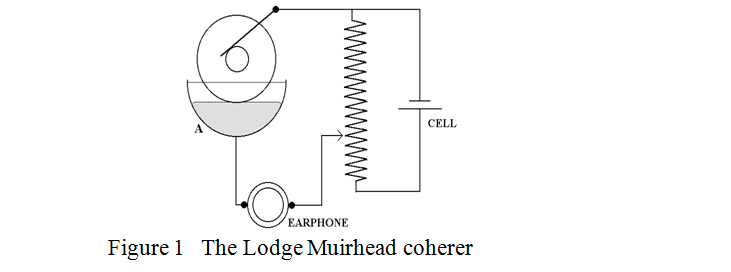Early last Century
| Back |
|---|
The Branly-Lodge coherer was the most sensitive detector of wireless waves known at that time, (the mid 1890s), but in its earliest form it needed several volts to make it “cohere” and go into its low resistance state. Considerable improvement in its sensitivity was soon achieved by, first, making the end plugs wedge shaped and moving them close together, and later, by adding minute amounts of mercury to the mix of metal filings, and finally partially evacuating the glass envelope. Unfortunately, they didn’t have calibrated signal generators in those days so there are no contemporary records of exactly what their sensitivity was. However, in 1901, 200 miles was achieved with a Rhumkorff coil and Branly-Lodge coherer. Needless to say, there was an intensive search for even more sensitive detectors to increase the communication range still further. One such improvement was the Lodge-Muirhead coherer illustrated in figure 1 below.

This consisted of a small metallic cup ‘A’, containing mercury. On this was placed a drop of oil, which forms a thin insulating film over it. Above the cup is a small iron disc with a sharp edge which is slowly rotated. The lower edge of the disc just touches the oil-covered mercury, but does not puncture the oil film. A single dry cell and a telephone receiver or siphon recorder are connected in series with the coherer. The application of electrical oscillations breaks down the insulating oil film and allows the cell to operate the receiving instrument. This form of coherer is self-resorting and needs no clockwork or electrical tapper.
Again, the sensitivity was not known but it was reputed to be much better than the Branly-Lodge type.
The most sensitive coherer of all was the “Castelli coherer”, or “Italian Navy coherer”, as it became known in Britain which was the type used by Marconi to receive the famous first Trans Atlantic signals. This looked rather like the original Branly-Lodge type with wedge shaped end electrodes, but with the metal filings replaced by a globule of mercury and a drop of oil. Although it was the most sensitive detector to RF voltage yet developed, it was also sensitive to vibrations such as those coming from a ship’s engines and to other disturbances, and it was soon replaced by a less sensitive but more reliable detector based on a totally different principle. This was “The Magnetic Detector”, or “Maggie” as it became known to naval telegraph operators. I have not attempted to build any of these later detectors, so I will not describe them further.
All the early experiments, including Marconi’s Trans Atlantic triumph were conducted with “untuned” equipment. i.e. the aerial and earth were connected directly across the transmitter spark gap and across the receiver coherer. The radiated and received fundamental frequencies were therefore mainly determined by the length of the antenna, probably acting as a quarter wave antenna tuned against ground. This would also efficiently radiate all the odd harmonics, and the bandwidth of radiation around each harmonic would be about 10% of the frequency, due to the “Q” of a single wire radiating element being about 10. In those very early days this was probably a great advantage for two reasons. Firstly, in the long distance tests it meant that appreciable energy was radiated not only at the fundamental wavelength of about 300 meters, (which is reflected by the comparatively low “D” layer in the atmosphere and thus doesn’t carry for long distances), but also at sub-multiples of this wavelength right up into the short wave bands. Secondly, coherers are sensitive to the peak voltage on the first pulse of the received signal and the short, high peak pulses generated by sparks are preserved by wide bandwidth. It would have been a definite disadvantage to sharply tune either the transmitter or the receiver, and Marconi was aware of this through practical experience. So in the early days, Marconi favoured untuned systems as they gave him headline making distance records. After all, apart from QRN, there was no competition on the airwaves.
However, this was all about to change. Marconi was a busy man and he often delegated his lectures and demonstrations to a trusted member of his team. One such was his senior scientific advisor, Dr Ambrose Fleming, who was the first to use a thermionic diode to detect wireless waves. Fleming had just finished the introduction to his lecture and had asked an assistant to turn on the receiver ready for a demonstration of receiving messages from two co-operating stations, one in Poldhu and one in Chelmsford, when the Morse printer burst into life. They stared at the tape in amazement, disbelief and then fury, for it began: “Rats There was a young man from Italy, who diddled the public so prettily”. The rest of the message was not recorded! The source of the message was a business rival of Marconi named Maskelyne who had set out to discredit the Marconi system and had set up a transmitter in an adjacent building. After that nearly all the competing companies converted to tuned systems which had to come of age soon anyway as the aether was becoming more and more crowded. In fact, telegraph operators could only receive the wanted message from among the babble of unwanted signals by concentrating on the different distinctive tones of the rasping spark generated Morse transmissions.
| Back |
|---|
John, G0NVZ